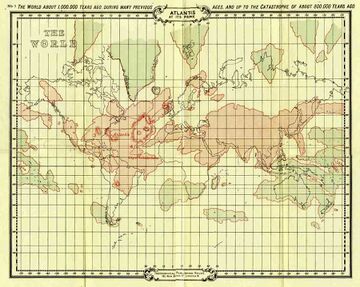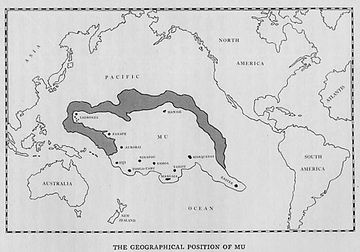Lemuria




Mu, o Lemuria, era el continente perdido del Pacífico que, según el descubrimiento de James Churchward, arqueólogo y autor de El continente perdido de Mu, se extendía desde el norte de Hawái a tres mil millas al sur, hacia la isla de Pascua y las islas Fiyi y estaba constituido por tres áreas de tierra que medían más de cinco mil millas de oriente a poniente.
La historia que relata Churchward de la antigua Tierra Madre está basada en los registros escritos en tablillas sagradas que asegura haber descubierto en la India. Con la ayuda de un sacerdote de un templo hindú, descifró dichas tablillas. Durante cincuenta años de investigación confirmó su contenido comparando con otros textos, inscripciones y leyendas que descubrió en el Sudeste de Asia, en Yucatán, Centroamérica, las islas del Pacífico, México, Norteamérica, el antiguo Egipto y otras civilizaciones. Él calcula que Mu fue destruido aproximadamente hace doce mil años, por el derrumbamiento de las cámaras de gas que sostenían al continente.
The culture of the Mother
El culto a la Madre, destinado a adquirir relevancia en el siglo XX, fue la base de la civilización de Lemuria, el continente perdido que se hundió bajo el Océano Pacífico hace muchos miles de años140. La evolución de la vida en la madre Tierra y sus colonias representó el impulso inicial del Espíritu en la Materia en este planeta. Aquí, donde las primeras razas raíz completaron los ciclos de su plan divino durante no una, sino varias eras doradas que alcanzaron su apogeo antes de la Caída del Hombre, el rayo masculino (las espirales descendentes del Espíritu) se plasmaba a través del rayo femenino (las espirales ascendentes de la Materia) en el mundo de la forma.
En el templo principal de Mu, la llama de la Madre Divina era venerada como la coordinadora de la llama del Padre Divino concentrada en la Ciudad Dorada del Sol. Perpetuando los antiguos rituales de invocación del Logos y la entonación de sonidos y mantras sagrados de la Palabra, sacerdotes y sacerdotisas del fuego sagrado sostenían el equilibrio de las fuerzas cósmicas a favor de las oleadas de vida del planeta. Se establecieron réplicas del templo y su foco llameante por todas las colonias remotas de Mu, como santuarios de la conciencia virginal, creando con ello un arco de luz entre la tierra y el sol, anclado en la llama de abajo y en la llama de arriba, que transmitía las energías del Logos necesarias para la precipitación de la forma y la sustancia en los planos de la Materia.
Mucho más allá de nuestros exiguos logros, los grandes avances tecnológicos realizados durante siglos de continua cultura en Mu surgieron gracias a una sintonía[1] universal con la Madre Divina, cuya conciencia abarca las leyes que gobiernan toda manifestación en el plano terrenal. Los logros en todos los ámbitos por parte de un pueblo dedicado al plan de Dios que se ha revelado por medio del Ojo Omnividente muestran cuán alto una civilización puede elevarse cuando se honra la llama de la Madre y se adora en cada corazón y se guarda y expande en los santuarios dedicados a su nombre. Se ve a las claras que la caída del hombre del estado de gracia fue, en realidad, la consecuencia de abandonar el culto a la Madre y abusar de las energías del átomo simiente concentrado en el chakra de la base de la columna, que ancla la luz de la llama de la Madre en el cuerpo físico.
La Caída del hombre en Lemuria
La caída de Mu, por consiguiente, fue el resultado directo de la Caída del hombre, que alcanzó su punto más bajo con la profanación de los santuarios de la Virgen Cósmica. Esto se produjo gradualmente al comprometer el Principio, separarse del Espíritu Santo y perder la visión, que es la consecuencia inevitable. Cegados por la ambición y la egolatría, los sacerdotes y sacerdotisas dejaron de mantener las llamas; al renunciar a sus promesas, abandonaron la práctica de esos rituales sagrados que habían permanecido intactos durante miles de años, si bien los ángeles sagrados mantienen perpetua vigilancia de la llama espontánea que arde sobre el altar del Dios Altísimo.
The worship of the Moon Mother, the Great Whore mentioned in the Book of Revelation,[2] replaced the worship of the Sun Mother, the Woman whom John saw “clothed with the sun, and the moon under her feet, and upon her head a crown of twelve stars.”[3] A black crystal set in lead and stone became the focus for the perversion of the Mother ray and the symbol of the new religion. One by one the inner circles of the temple orders were violated through the diabolical practice of black magic and phallic worship taught by the Luciferians, until a completely false theology wiped out the pristine patterns of the Mother Cult.
Life on the continent of Mu was further corrupted by aliens and fallen angels with their grotesque genetic miscreations, mocking the Godhead and violating the sacred science of the Mother by engaging men in wars of the gods.
The sinking of Lemuria
By and by the early rumblings of cataclysm were heard by the inhabitants of Mu. The altars of the most remote colonies were the first to topple. When the last strongholds—the twelve temples surrounding the main temple—were taken over by the Satanists, the momentum of light invoked by the remnant of the faithful was not great enough to hold the balance for the continent.
Thus Mu finally sank by the sheer weight of Darkness that her children had invoked—and which, because their deeds were evil, they had come to love more than the Light. She went down in a horrendous mass of volcanic fire and exploding lava, and the flame focuses that had sustained a mighty people and a mighty civilization were no more. What had taken hundreds of thousands of years to build up was torn down in a cosmic interval—the achievements of an entire civilization lost in oblivion, the spiritual-material evolution of man stripped from his outer memory!
The loss of the Mother flame
Devastating though that cataclysm was for millions of souls, of far greater consequence was the destruction of the focus of the Mother flame that had blazed on the altar of the main temple—a life-giving fire, the insignia of each man’s Divinity made manifest as Above, so below. Alas, the torch that had been passed was let fall to the ground. The strategies of the fallen ones, who had worked night and day with a fanatical zeal, were successful in accomplishing their end: the Mother flame was extinguished on the physical plane.
For a time it looked as though the Darkness had completely enveloped the Light. Beholding the defection of the race, cosmic councils voted to dissolve the planet whose people had forsaken their God; and this would have been its fate had Sanat Kumara not interceded, offering to exile himself from Hesperus (Venus) in order to keep the flame on behalf of mankind and hold the balance of the Light for Terra until such time as mankind should return to the pure and undefiled religion of their ancient forebears.
Although the physical focus of the Mother flame was lost when Mu went down, the feminine ray has been enshrined on the etheric plane by the God and Goddess Meru in their temple at Lake Titicaca.
Paradise lost
The souls who perished with the Motherland reembodied upon a naked earth. Their paradise lost, they roamed the sands whose atoms were etched with the edict of the LORD God “Cursed is the ground for thy sake....”[4] Having no recall of their former estate and no tie thereto—for they lacked the Flame—they reverted to a primitive existence. Through disobedience to the laws of God, they forfeited their self-mastery, their right to dominion, and their knowledge of the I AM Presence. Their threefold flame was reduced to a mere flicker and the lights in their body temples went out.
Man, no longer found in the image of the Christ, became one of the species (Homo sapiens), an animal among other animals, his God-potential sealed for a thousand days of cosmic history. Thus began the tortuous trek of evolution that has brought civilization to its present level and which is intended to culminate in a golden age of Christ-mastery and full God-realization.
See also
For more information
For additional teaching on Lemuria and its fall, see Mark L. Prophet and Elizabeth Clare Prophet, The Path of the Higher Self, volume 1 of the Climb the Highest Mountain® series, pp. 60–78, 411–14.
See also James Churchward, The Lost Continent of Mu (1931; reprint, New York: Paperback Library Edition, 1968).
H. P. Blavatsky, The Secret Doctrine, Vols. I and II, (Pasadena, Ca.: Theosophical University Press, 1888, 1963), check index for references to Lemuria.
Sources
Pearls of Wisdom, vol. 31, no. 26, June 12 1988.
Mark L. Prophet and Elizabeth Clare Prophet, The Path of the Higher Self, volume 1 of the Climb the Highest Mountain® series, pp. 411–14.
